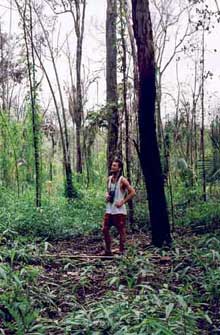Amazon wildfires contribute to carbon problem

Amazon rainforest burnt three timesand pictured after 4 years with Dr Barlow pictured
More trees are dying following forest fires in the Amazon than was previously thought, according to new research from the University of East Anglia (UEA).
Trees that initially appear to survive fires, such as those caused by El Niño, are in fact dying two to three years later, increasing carbon emissions and causing further loss of Amazonian vegetation.
Dr Barlow of UEA’s School of Environmental Sciences found that many of the large, thicker-barked trees that survive up to two years following ground fires had died after three years, dramatically reducing the amount of carbon stored in living trees.
“Three years after the fires the amount of viable tree-life is less than half of that found in unburned areas of forest,” said Dr Barlow.
“These wildfires make substantial contributions to atmospheric carbon dioxide, a fact that will take on further significance as El Niño events threaten to become increasingly frequent and severe,” he continued.
The research is published this month in the journal Ecology Letters.
Media Contact
All latest news from the category: Ecology, The Environment and Conservation
This complex theme deals primarily with interactions between organisms and the environmental factors that impact them, but to a greater extent between individual inanimate environmental factors.
innovations-report offers informative reports and articles on topics such as climate protection, landscape conservation, ecological systems, wildlife and nature parks and ecosystem efficiency and balance.
Newest articles

A universal framework for spatial biology
SpatialData is a freely accessible tool to unify and integrate data from different omics technologies accounting for spatial information, which can provide holistic insights into health and disease. Biological processes…

How complex biological processes arise
A $20 million grant from the U.S. National Science Foundation (NSF) will support the establishment and operation of the National Synthesis Center for Emergence in the Molecular and Cellular Sciences (NCEMS) at…

Airborne single-photon lidar system achieves high-resolution 3D imaging
Compact, low-power system opens doors for photon-efficient drone and satellite-based environmental monitoring and mapping. Researchers have developed a compact and lightweight single-photon airborne lidar system that can acquire high-resolution 3D…





















